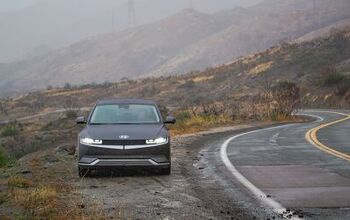2025 Hyundai Ioniq 5 First Drive Review: Even Better
In its first three years on the market, the Ioniq 5 collected awards like Meryl Streep and saw its sales consistently increase. The goal for the updated 2025 Hyundai Ioniq 5 was, effectively, don’t mess it up.
After driving a dual-motor Limited around Palm Springs, California, and into the snowy San Jacinto mountains, I can happily report that Hyundai achieved that goal. It’s just as well-rounded and generally impressive as it was before but with a handful of smart changes that improve functionality, range and charging.
There’s also a new member of the family, the Ioniq 5 XRT, an off-roader(ish) model that satisfies the buying public’s demand for such ruggedly flavored creations.
What’s New for 2025:
The Ioniq 5’s battery packs are upgraded, yielding range improvements that are heavily dependent upon drivetrain and trim level. The Long Range trim levels can still recharge at a blazing rate of 250 kilowatts, but if you’re OK sacrificing some charging speed for convenience, every Ioniq 5 except the N can now use Tesla Superchargers thanks to its new NACS charge port.
There are also subtle exterior design tweaks, while the interior sees smart functional changes and Hyundai’s latest tech interface. The bigger news, however, is the new XRT. This quasi-rugged model gets an extra inch (or 23 millimeters) of ground clearance, better approach and departure angles, all-terrain tires, special wheels, suspension tuning changes, unique Terrain drive modes, tow hooks, and special “digital camouflage” plastic body cladding.
Exterior Style:
For 2025, the Ioniq 5’s lower bumpers have been tweaked, there’s a new rear spoiler and more aerodynamic wheel designs, and Hyundai has answered customer feedback by making roof rails available and a rear wiper standard.
There’s no missing the changes made for the Ioniq 5 XRT, however. The distinctive plastic cladding, with its embossed, Tetris-like print, is boldly placed on the front fascia along with red tow hooks and a matte gray trim that also appears on the side sills and lower rear bumper. The “digital camo” cladding reappears on the wheel arches and the rear fascia. It’s a lot, but the print makes it look more finished and purposeful than if it was just the matte gray stuff.
All-terrain tires are fitted to black-painted alloy wheels inspired by old-school steelies. Black badging and mirror caps round out the XRT’s unique details, while Ultimate Red and Cosmic Blue Pearl are exclusive color options.
Powertrain and Fuel Economy:
Electric motor outputs are unchanged for 2025, leaving you with the same options. The rear-wheel-drive, single-motor Standard Range model produces 168 horsepower and 258 pound-feet of torque. The Long Range’s single motor is good for 225 hp and 258 lb-ft of torque. The all-wheel-drive Long Range model keeps the same rear motor, but adds a front motor for a total output of 320 hp and 446 lb-ft of torque.
All of the above get upgraded battery packs. The Standard Range goes from 58 kilowatt-hours to 63 kWh, resulting in range going from 220 miles (354 kilometers) to a less anxiety-causing 245 (394 kilometers). All rear-drive Long Range models see an increase from 303 miles (488 kilometers) to 318 (512).
Range differs greatly amongst the various dual-motor, all-wheel-drive trim levels in the United States. In Canada, where there’s only a Preferred trim level, the difference boils down to wheel choice. The American SE and SEL (equivalent to Canada’s Preferred Long Range AWD) see the largest increase of the entire lineup, going from 260 miles (418 kilometers) to 290 (467). The Limited, or “Ultimate with Preferred Package” in Canada, only goes up to 269 (431) from that same 260. Blame the 20-inch wheels, but it could be worse. The XRT actually goes down to 259 miles (417 kilometers) due to its increased ground clearance and all-terrain tires.
Handling and Drivability:
Without any suspension, steering or even motor changes, the dual-motor Ioniq 5 Limited I drove sure feels exactly the same as before. It still hides its bulk well (unlike many EVs) and is poised around corners – it can even feel playful at times. The steering isn’t anything to wax poetically about, but it’s also precise, well-weighted and didn’t have me instinctively pressing the Sport button. The regenerative braking system is just as good as always, providing drivers one of four levels of off-throttle braking at the pull of a wheel paddle (versus nine stabs of a touchscreen).
As for the XRT, I really only drove that on dusty, rocky desert trails. If that’s the sort of off-roading you envision doing, going for the XRT is an obvious choice over the standard Ioniq 5. Anything more challenging and you’ll likely find that its 7 inches of ground clearance (17.8 centimeters) is a limiting factor. For some context, an Audi A4 Allroad has 6.5, a Volvo V60 Cross Country 8.1, and most Subaru Outbacks 8.7.
There was a particular spot on the trail where I couldn’t avoid bottoming out the XRT. I was thankful that Hyundai made a point to discuss the XRT’s underbody/battery protection … or lack thereof. Engineers considered fortifying the XRT’s underbody, but ultimately determined that the Ioniq 5’s existing battery shielding was robust enough to withstand whatever increased threats the XRT might encounter. Still, it’s not like thwacking the bottom of your car is ideal.
Beyond that, the XRT’s Terrain mode locks the dual motors into a 50/50 power distribution, recalibrates the throttle and tweaks the stability control system based on whether you select the Sand or Mud sub-settings (there’s also a Terrain Snow mode that shuts off over 20 mph). The result is a car that can be slid about on sand without the car’s electronic nannies freaking out and dampening the fun. This is really where the XRT can make sense.
Ride Quality and Comfort:
Lots of SUVs are getting fitted with all-terrain tires these days and a lot of those end up riding like garbage. Every little pavement imperfection can get transmitted into the cabin. It was with this in mind that I briefly tested the XRT on road. I am happy to report that the ride remained tolerable over a series of sharp bumps and broken pavement. Harsh it was not, although you’ll definitely still find a smoother ride in other versions. There was also more road noise, but again, it wasn’t excessive.
The Limited remained comfortable throughout the drive over pavement of differing quality despite its 20-inch wheels. It’s also the only trim level to include the “Relaxation” driver’s seat that, beyond adding a power-deploying footrest to use while parked, adds substantially more seat tilt adjustment highly beneficial for tall drivers like myself.
Interior Style and Quality:
Interior quality differs by trim level. In the Limited, the doors are covered in soft, padded simulated leather. In XRT and other lower trims, it’s hard, OK-textured plastic. All-black interiors are also notably stark in appearance. That said, this is still a cool, modern interior that strikes a good balance between minimalized futurism and functionality.
Case in point: there are actually more physical controls for 2025 – imagine that! Buttons for the available heated and ventilated seats, heated steering wheel and parking sensors are no longer touch-sensitive controls shoe-horned into the climate/infotainment control area (thereby making that easier to use). They’re now physical buttons on the sliding center console, a set-up found in most other Hyundais and one apparently preferred by owners and car reviewers alike (this one included). That center console has also been redesigned to include a bigger, grippier and more easily accessed wireless charge pad along with better cupholders.
Tech and Safety:
The infotainment system is upgraded to Hyundai’s latest, complete with now-wireless Apple CarPlay and Android Auto. You not only had to plug your phone in before, the USB-A plug was in a bin down by your feet. The new tech interface is quicker and looks perfectly modern, but the old system wasn’t exactly antiquated.
The instrument panel, however, had its issues. Specifically, the speedometer and range readouts could be hidden behind the wheel rim regardless of the driver-selectable layout/design. With the 2025’s handful of new layouts/designs, including several more traditional gauge-style ones, I can now see how fast I’m going and how far I can go. Good. Should there be any other such issues that arise in the future, the Ioniq 5 can now be more easily changed thanks the addition of over-the-air update capability.
Safety and driver assistance technologies see upgrades as well. An in-camera camera/driver monitoring system makes sure you’re paying attention, and the rear occupant alert system now uses radar to determine if someone is back there instead of just automatically and blindly telling you to check the back seat for something alive. There are upgrades to parking assistance tech, too, depending on trim level.
Value, Dollars, Sense:
Every Ioniq 5 but the N will now be built in Georgia, which for those in United States, opens the door to federal tax credits. Purchases will be eligible for a $3,750 credit at first, while leases can net the full $7,500. The purchase credit should, theoretically, go up to the full amount once Hyundai’s American battery pack becomes operational. Of course, the federal government could also choose to end tax credits altogether. In Canada, the Ioniq 5 is eligible for a maximum $5,000 federal tax credit (less for lease terms less than 48 months).
In the United States, prices for the SE and Limited trim level only go up by a couple hundred bucks, while the SEL is bumped up by about a couple thousand. The new XRT starts at $55,400 in the United States.
The Standard Range model wasn’t available in Canada before, which means it’s addition to the lineup effectively lowers the Ioniq 5’s starting price for 2025 to $52,999. The Long Range goes up by about $500 to $55,499. The XRT had not been priced at the time of this writing.
Final Thoughts: 2025 Hyundai Ioniq 5 Review
The 2025 Hyundai Ioniq 5 is an even better and competitive electric vehicle, especially as its access to Tesla Superchargers significantly reduces range and charging anxiety. Access to American federal tax credits also improves its value relative American-built rivals. The XRT is ultimately a fine addition to the lineup, but its certainly more style than substance.
Become an AutoGuide insider. Get the latest from the automotive world first by subscribing to our newsletter here.
More by James Riswick










































Comments
Join the conversation